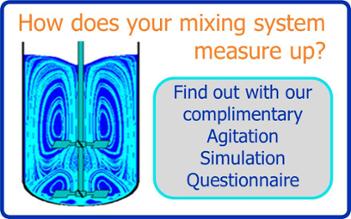Best Practices for Low Volume Mixing in Reactors
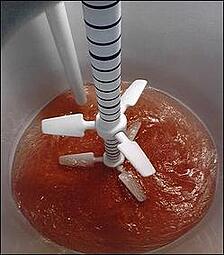 Typically, when you purchase a glass-lined vessel, you specify it according to the batch size of your intended process. Sometimes, however, it is necessary (or desirable) to run smaller batches in existing equipment that was designed for much higher volumes. Low level mixing is also inevitable when your vessel contents require constant agitation, even during emptying of the reactor. But is it even possible to mix 5 gallons of product in a 500-gallon vessel? The answer is yes, but there are cautions, rules, and guidelines that should be obeyed in order to successfully accomplish low-level mixing. In this post we’ll tell you all about them, so you can run your agitator correctly and safely in small batches.
Typically, when you purchase a glass-lined vessel, you specify it according to the batch size of your intended process. Sometimes, however, it is necessary (or desirable) to run smaller batches in existing equipment that was designed for much higher volumes. Low level mixing is also inevitable when your vessel contents require constant agitation, even during emptying of the reactor. But is it even possible to mix 5 gallons of product in a 500-gallon vessel? The answer is yes, but there are cautions, rules, and guidelines that should be obeyed in order to successfully accomplish low-level mixing. In this post we’ll tell you all about them, so you can run your agitator correctly and safely in small batches.
Minimum Mixing Levels with GlasLock Blades
Our GL series reactors feature GlasLock, an interchangeable glass-lined agitator blade system. The following table shows the standard minimum agitated volume (light blue) and possible minimum agitated volume (blue) that can be achieved when the agitator is moved to the lowest point of the vessel. This data is for GlasLock blades installed at a 45-degree angle:
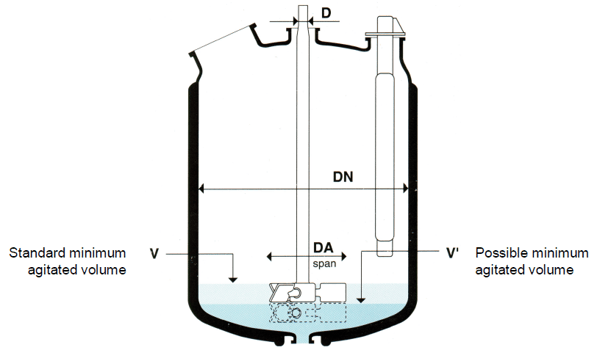
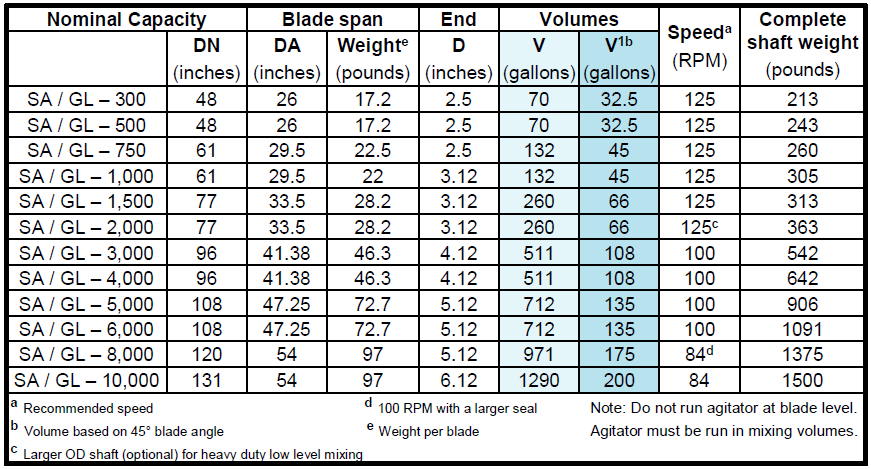
It is critical to never run the agitator at blade level; it must always be run in mixing volumes to ensure safe mixing. When the agitator is run with the fluid in the vessel below the blade level, fluid flow causes the shaft to “skate”, resulting in excessive stresses and runout in the seal area and upper end of the agitator. This can cause premature seal failure and even glass damage on the agitator itself.
Agitator Operation During Emptying/Filling of Vessel
So now you know the guidelines for running an agitator based on the liquid level in the vessel. But what are the best practices for running an agitator when the vessel is being filled or emptied?
An agitator should never be run at full speed while a vessel is empty or during slow draining of the vessel, especially if the liquid will be at the blade level for any appreciable time. However, when extra care is taken, an agitator can run at full speed during the emptying of the vessel. The caveats are:
- it must be done quickly.
- the liquid level should not be held at the blade level for any appreciable length of time.
- the viscosity is not increasing.
- while vessel level is decreasing, the agitator speed must be slowed while the liquid drops to 8-10” above the blade level.
In the case of filling a vessel, it is generally okay to start and run the agitator during filling, provided that the filling is done quickly, and the liquid level is not held at blade level. When liquid is added, the agitator should run slowly, and the speed should be increased as the level increases. “Down-pumping” is required, in which the impeller is rotated so that the blades push the fluid in a downwards manner.
OptiFoil Blade Technology for Low-Level Mixing
If you want to maximize your mixing capabilities even further than what standard GlasLock blades enable, the OptiFoil design is an upgraded feature to consider. OptiFoil blades combines the advantages of hydrofoil agitator blades and trapezoidal agitator blades for improved mixing in glass-lined vessels. The geometry of the blades maximizes the pumping action required for homogenization, suspension, heat transfer and crystallization of fragile particles. Furthermore, the shape of the blade produces effective mixing of minimum product volumes, creates strong flow at the reactor bottom, and facilitates evacuation of the vessel by reducing the gap between the blades and the bottom of the reactor, keeping particles in suspension while they exit the vessel.
The following chart lists the minimum mixing volume that OptiFoil can accommodate in a range of vessel sizes at the designated liquid levels:
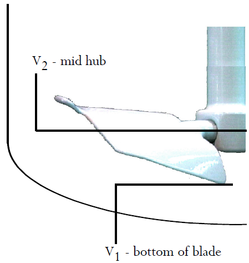 |
|
The pitch angle of the OptiFoil blades also results in smoother contact with the product than vertically-oriented trapezoidal blades, creating shear and preventing the alteration of fragile crystals. In addition, the blades can mix higher viscosity liquids than hydrofoil blades or standard flat blades, producing axial and radial flow characteristics that are suitable for virtually every process.
OptiFoil blades are available in a range of sizes to match your process and vessel capacity. They can be purchased as a one-piece agitator, or as removable blades when used in conjunction with our GlasLock blade system.
If there’s anything we can do to assist you in optimizing your mixing, contact us online or fill out our Agitation Simulation Questionnaire to get a complimentary assessment of your current mixing practices and what can be done to improve the efficiency of your process.
